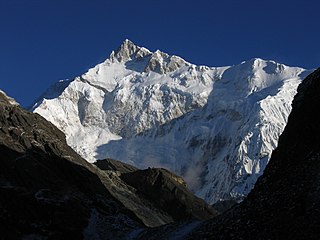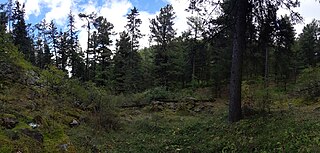
Man and the Biosphere Programme (MAB) is an intergovernmental scientific program, launched in 1971 by UNESCO, that aims to establish a scientific basis for the 'improvement of relationships' between people and their environments.

There are 18 biosphere reserves in India. They protect larger areas of natural habitat than a typical national park or animal sanctuary, and often include one or more national parks or reserves, along with buffer zones that are open to some economic uses. Protection is granted not only to the flora and fauna of the protected region, but also to the human communities who inhabit these regions, and their ways of life. In total there are 18 biosphere reserves in India.

Khangchendzonga National Park, also Kanchenjunga Biosphere Reserve, is a national park and a biosphere reserve located in Sikkim, India. It was inscribed to the UNESCO World Heritage Sites list in July 2016, becoming the first "Mixed Heritage" site of India. It was included in the UNESCO Man and the Biosphere Programme. The park is named after the mountain Kangchenjunga, which is the third-highest peak in the world at 8,586 m (28,169 ft) tall. The total area of the park is 849.5 km2 (328.0 sq mi).

The Golden Gate Biosphere Network is a voluntary coalition of federal, state, and local government agencies, nonprofit organizations, universities, and private partners within the Golden Gate Biosphere region. The Network aims to protect the region's biodiversity and conserve its natural resources, enhancing quality of life for local residents. The Network has been part of the UNESCO Man and Biosphere Programme since 1988 and is part of the US Biosphere Network and EuroMAB. It is recognized by UNESCO due to the significant biodiversity of the region, as well as the Network's efforts to demonstrate and promote a balanced relationship between humans and the biosphere.

Protected areas of Poland include the following categories, as defined by the Act on Protection of Nature of 16 April 2004, by the Polish Parliament:

An urban biosphere reserve is an attempt to apply the biosphere reserve concept to urban areas by the MAB Programme of UNESCO. Through urban planning and ecosystem management, an urban biosphere reserve is expected to support sustainable development and conservation. Brighton and Hove is bidding to become the world's first urban biosphere reserve.
Under UNESCO’s Man and the Biosphere Programme, there are 308 biosphere reserves recognized as part of the World Network of Biosphere Reserves in Europe and North America. These are distributed across 41 countries in the region.
The Kruger to Canyons Biosphere Region is a biosphere reserve situated in the north eastern region of South Africa, straddling Limpopo and Mpumalanga Provinces. In 2001, under the supervision of the then Department of Environmental Affairs (DEA), the Kruger to Canyons Biosphere Region was officially ratified by UNESCO as part of the Man and the Biosphere (MaB) Programme. UNESCO's Man and the Biosphere Programme provides a framework for exploring local solutions to challenges by mainstreaming biodiversity conservation and sustainable development, integrating economic, social and environmental aspects and recognising their vital linkages within specific learning landscapes adjacent to Protected Areas.

The World Database on Protected Areas (WDPA) is the largest assembly of data on the world's terrestrial and marine protected areas, containing more than 260,000 protected areas as of August 2020, with records covering 245 countries and territories throughout the world. The WDPA is a joint venture between the United Nations Environment Programme World Conservation Monitoring Centre and the International Union for Conservation of Nature World Commission on Protected Areas.
Biosphere reserves are established according to the UNESCO's Man and the Biosphere Programme (MAB) to promote sustainable development for conservation of biological and cultural diversity. As of 2016, the Lal Suhanra Biosphere Reserve and Ziarat Juniper Forest are the only two biosphere reserve in Pakistan, which were approved by UNESCO in 1977 and 2013 respectively. A number of initiatives and projects have been undertaken to promote and develop other biosphere reserves in Pakistan but due to weak implementation this has not yet been materialized. In July 2012, Pakistan Museum of Natural History and Beijing Museum of Natural History signed a MoU to work on trans-boundary biodiversity and to improve MAB related activities in the Karakoram, Himalaya, and Hindukush regions.

The Frontenac Arch Biosphere Reserve is a UNESCO Biosphere Reserve located in southeastern Ontario, Canada. The biosphere reserve was designated in 2002, and is one of 16 biosphere reserves in Canada. The Frontenac Arch Biosphere operates primarily within a 2,700 km2. region from Brockville to Kingston, extending north to Verona and Perth.

Bogd Khan Uul Biosphere Reserve is a nature reserve situated to the south of Ulaanbaatar in Mongolia. It is in the southern part of the forest steppe zone and is in the Khentii Mountains area. It includes Bogd Khan Mountain, and was designated as a UNESCO Biosphere Reserve in 1996. It claims to be the oldest National Park in the world.
Mongol Daguur Biosphere Reserve is a nature reserve in the Dornod Aimag (Province) in eastern Mongolia, preserved as an example of one of the largest areas of intact grassland in the world. It covers 8,429,072 hectares and was designated as a UNESCO Biosphere Reserve in 2005. Together with Ugtam Nature refuge and Daursky Nature Reserve in Russia it constitutes a World Heritage Site named "The Landscapes of Dauria".
The Yayu Coffee Forest Biosphere Reserve is situated in Illubabor Zone of the Oromia Regional State, southwestern Ethiopia.

Waterton Biosphere Reserve is a UNESCO Biosphere Reserve encompassing Waterton Lakes National Park in the extreme south-west of the Province of Alberta, Canada. The reserve includes a section of the east slopes of the Rocky Mountains extending from the Continental Divide to the edge of the Canadian Great Plains to the east. The Glacier Biosphere Reserve and National Park in Montana, USA is located to the south of the area. The reserve is administered by Waterton Lakes National Park and the Waterton Biosphere Association.

The Redberry Lake Biosphere Region was established in 2000 as a UNESCO Biosphere Reserve covering 112,200 ha in the province of Saskatchewan, Canada. In 2019, the reserve expanded to become a region including the Redberry Lake watershed and surrounding land encompassing close to 700,000 ha of land. The regional landscape is composed of rolling prairie dotted with seasonal ponds and marshes along with aspen/shrub groves. The core area is Redberry Lake, a saline lake with several islands. There are small patches of natural mixed prairie which are very rare in this highly grazed and cultivated part of the prairies. The Redberry Lake Biosphere Region is committed to balancing conservation with sustainable development.
The Cape Winelands Biosphere Reserve is located in the Western Cape Province of South Africa approximately 40 km (25 mi) east of Cape Town. The Biosphere Reserve extends from the Kogelberg Biosphere Reserve in the south, northwards along the Cape Fold Belt Mountain Chain and the adjoining valleys constituting the Cape Winelands. The Biosphere Reserve incorporates key portions of the registered Cape Floral Region Protected Areas World Heritage Site. The Reserve was designated in 2007.
The United Nations Educational, Scientific and Cultural Organization (UNESCO) Biosphere Reserves are significant institutions of international status as described in the established order of the World Network of Biosphere Reserves within the framework of the Man and the Biosphere Programme. The biosphere reserves specifically promote and support sustainable development for conservation of biological and cultural diversity.












